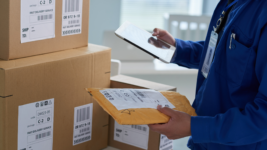On June 1, hurricane season officially began (and hopefully you and your company are preparing accordingly).
Unfortunately, a hurricane isn’t the only serious tempest we have to worry about this summer, because right now there’s a stormy contract debate brewing between the Teamsters and one of the country’s largest parcel carriers – and all signs suggest that it could make landfall shortly after July 31.
We’re talking, of course, about the possible UPS strike and its potential repercussions for countless U.S. supply chains.
“Some people are still speaking in terms of “if” UPS strikes. But with each day that passes, the possibility of the “if” turning into a “when” is becoming more probable,” said AFS’s Chief Channel Development Officer, Dean Jones. “In fact, most shippers have already made parcel decisions in the wake of a potential strike after July 31st, but hopefully we don’t see a repeat of 1997.”
We recently sat down with him to learn more.
First things first. What’s the current weather like between the Teamsters and UPS?
Fair to partly gloomy.
Way to bring the mood down. Who are you, Jim Cantore?
Sorry, but that’s just the truth. You’re looking at two huge, strong organizations led by two new presidents who feel like their predecessors were either too soft or too accommodating during previous contract negotiations. Plus, you’ve got 340,000 employees who are frustrated by a company that has repeatedly announced record profits and record rate increases over the past few years – none of which has been reflected in their paychecks.
So, sum up each side’s perspective in 100 words or less.
Among other things, the Teamsters are aiming to resolve employee issues like two separate pay grades, hours, benefits, excessive overtime and lack of air conditioning in some of the vehicles. They’re also looking to get members “their fair share” of the mega-earnings UPS has posted over the last few years.
UPS is trying to protect its profit margin at a time when parcel volumes and revenues are starting to precipitously decline – and when it’s trying to cut costs, not increase them.
Walk us through the last time a strike happened.
It was 1997, and UPS controlled about 80% of the ground parcel delivery market. The strike lasted 15 days, stopped approximately 80% of their shipments, and significantly delayed the delivery of 7 million packages.
They lost between $780 to $850 million over the course of the strike (depending upon whom you ask). It inadvertently opened the door to several other competitors, like FedEx, taking a permanent chunk of its business.
Would a 2023 UPS strike be better or worse?
It depends on what metrics and facts you’re looking at.
Can we start with some encouraging ones?
Sure. Unlike how things were in 1997, UPS controls a smaller portion of the U.S. parcel delivery market – “just” 37% – with FedEx very close behind at 33%, and Amazon slowly but surely gaining at 12%. So, a much smaller percentage of the country’s parcels would be involved. In addition, many regional carriers have recently made some major acquisitions and expansions that have come close to making their networks nearly national. Plus, there are a number of other non-traditional but intriguing delivery alternatives like Uber, that have yet to be explored. As a result, shippers have many more viable options for diverting their UPS shipments than they did 26 years ago.
Okay. Now we’re ready to hear the less encouraging stats.
We are a much more parcel-delivery-dependent economy than we were then. For example, UPS alone delivers 24.3 million packages per day in the United States, which is significantly more than the 12 million U.S. packages it delivered per day in 1997. Because of this, there’s more potential for supply chain disruption overall.
Moreover, thanks largely to Amazon, consumers expect to receive their deliveries far more quickly than they did in 1997, and they’re less tolerant of delivery lapses. As a result, there’s a much greater chance of UPS shippers disappointing (and losing) some of their customers if a strike occurs and they’re unable to successfully divert their usual packages to other carriers.
What are UPS’ competitors saying about all of this?
The truth – that no one carrier will be able to absorb all of the extra volume that a strike would create. And companies need to be exploring and putting together different shipping scenarios sooner rather than later. By the way, all of us here at AFS have been saying the same thing for several months.
Let’s talk briefly about what some of those different scenarios are.
For many shippers, the most obvious solution would be to move their UPS shipments to FedEx as needed. It’s the other member of the parcel delivery duopoly, and everything from its rates to its national network and delivery service levels are comparable to UPS’. The problem is, even FedEx has said that it can’t absorb all of UPS’ capacity. And when it comes to prioritizing whose packages it will be willing to deliver quickly in the wake of a strike, it will be making a distinction between companies that were official FedEx customers by March 31 and those that weren’t.
Regional carriers are another possibility. Many, like OnTrac, offer near-national reach with systems, customer service levels and delivery times that are comparable to or better than those of FedEx or UPS, and it’s possible that most will welcome the possibility of attracting and demonstrating their capabilities to new clientele. However, some of them have also made it clear that they’re not interested in merely being a stopgap while there’s a strike and then being kicked to the curb when UPS service has been restored. Instead, they’ll be looking for a longer-term commitment to using their services. And like FedEx, some of these carriers could quickly see their capacity maxed out as a strike draws near.
The U.S. Postal Service is another option, although its speed and reliability lag behind UPS and FedEx, and those aren’t likely to improve if a large portion of UPS’ 23-million-plus daily packages are suddenly introduced into its delivery stream.
Last but certainly not least, let’s not forget that Amazon also has a home delivery network that delivers nearly 10 million packages per day worldwide (although it’s also a major UPS client) – and there are other kinds of home delivery or passenger pick-up services like Doordash and Uber that could, with some highly creative thinking, be selectively pressed into service for parcel delivery instead.
Seriously, Doordash and Uber?
Well maybe not on a wide scale basis for this particular situation (although stranger things have been known to happen). But bear in mind that you are looking at companies that have millions of drivers and considerable home delivery experience. And if they can pick up and deliver something as time-sensitive as meals or as particular as people, what’s to prevent some highly innovative shipper from finding a way to apply those same skill sets to packages?
Perhaps that will be more of a possibility when the 2028 Teamsters-UPS negotiations roll around!
You never know. After all, circumstances like this possible strike have been known to inspire or accelerate innovative solutions in the past.
Any final words of advice before we bring this interview to a close?
If you’re one of the many wise shippers who have already begun making adjustments to your parcel shipping carrier mix in anticipation of this strike, stay the course and continue to work that plan, because it’s becoming increasingly likely that you may have to use it. No matter what happens, you won’t regret having a more updated contingency plan in place.
By contrast, if you haven’t seriously considered the possibility of a strike already, now’s the time to put your finest contingency planning, negotiating and optimization skills to use. While some of the best or most obvious parcel delivery capacity may no longer be available, it’s never too late to make key adjustments to your network, delivery promises, carrier mix and more.
Finally, feel free to keep AFS on speed dial as this story continues to unfold. We’re tracking it closely ourselves on behalf of our own company and more than 1,800 customers, and we’d be happy to discuss the options that are available to your company.





